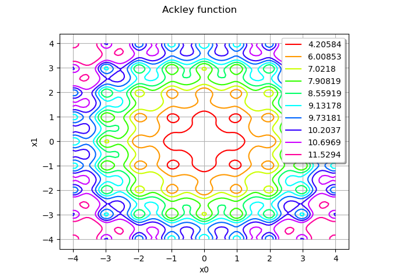The Branin test case¶
Introduction¶
The Branin function is defined in 2 dimensions based on the functions :
and :
Finally, the Branin function is the composition of the two previous functions:
for any .
There are three global minimas:
and :
where the function value is:
We assume that the output of the Branin function is noisy, with a gaussian noise. In other words, the objective function is:
where is a random variable with gaussian distribution.
This time the AEI formulation is used, meaning that the objective has two outputs: the first one is the objective function value and the second one is the noise variance.
Here we assume a constant noise variance:
References¶
Dixon, L. C. W., & Szego, G. P. (1978). The global optimization problem: an introduction. Towards global optimization, 2, 1-15.
Forrester, A., Sobester, A., & Keane, A. (2008). Engineering design via surrogate modelling: a practical guide. Wiley.
Global Optimization Test Problems. Retrieved June 2013, from http://www-optima.amp.i.kyoto-u.ac.jp/member/student/hedar/Hedar_files/TestGO.htm.
Molga, M., & Smutnicki, C. Test functions for optimization needs (2005). Retrieved June 2013, from http://www.zsd.ict.pwr.wroc.pl/files/docs/functions.pdf.
Picheny, V., Wagner, T., & Ginsbourger, D. (2012). A benchmark of kriging-based infill criteria for noisy optimization.
Load the use case¶
We can load this classical model from the use cases module as follows :
>>> from openturns.usecases import branin_function as branin_function
>>> # Load the Branin-Hoo test case
>>> bm = branin_function.BraninModel()
API documentation¶
See BraninModel.
 OpenTURNS
OpenTURNS
